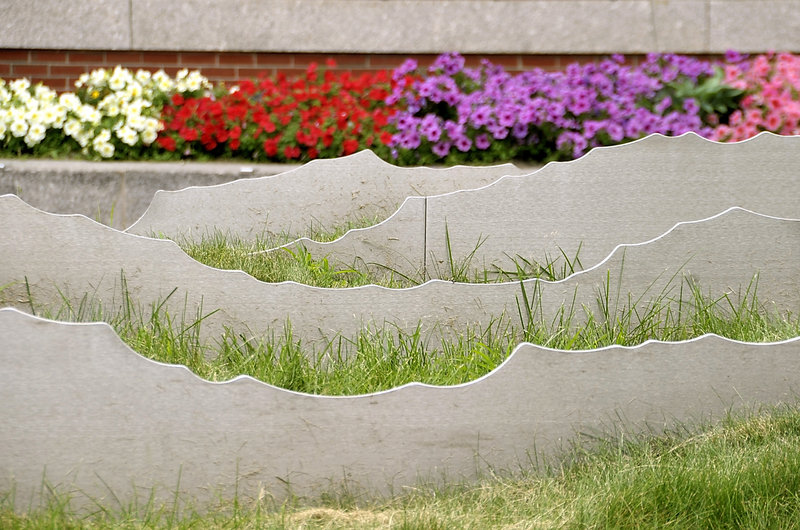PORTLAND – Over four years ago, the Public Art Committee embarked on an exceedingly rare and exciting endeavor — to commission a new piece of art for the city of Portland.
The vast majority of our volunteer work is consumed with the mundane tasks of preserving our existing collection of public art works, overseeing new gifts of art to the city, and establishing guidelines that govern such work.
We receive about one-half of 1 percent of the city’s Capital Improvement Plan (roughly $50,000 annually) and every few years we are able to save enough money in order to buy a new piece of public art for the city.
It was with great expectation and enthusiasm that we chose the artist Shauna Gilles-Smith to design and oversee the installation of a landscape art work for Boothby Square. Gilles-Smith’s winning entry, “Tracing the Fore,” was chosen after a national competition and tremendous input over the course of many public forums.
She was one of the principals at a successful landscaping firm in Boston and came with sterling credentials.
Many folks asked that the winning entry would incorporate an element that suggested the historic nature and use of the square, and in fact Gilles-Smith’s piece specified metal and earthen “waves,” reminiscent of the time when Fore Street was the actual harbor waterfront, with a sea wall running along the north side of the street.
With very generous donations we were also able to secure the original Boothby Square fountain and re-install this beautiful granite piece on its original site.
Though the installation took much longer than expected and a building boom contributed to material cost overruns, we still looked forward to the finished piece. Gilles-Smith’s fine graphic illustrations depicted an undulating pattern of beautiful grasses, gently billowing in the breezes much like the ocean waves a short distance away
The rigid stainless steel wave cut-outs would re-enforce and reflect the earthen ones, similar to the shimmering quality one sees when looking over ripples on the sea. Throughout the process we addressed public concerns about safety and modified the piece, rounding the top edges of the stainless steel to prevent people from injuring themselves.
I can happily write that after more than four years in place, there have not been any complaints of injury related to the art work.
Unfortunately, other elements have been much less successful. While the “hardscaping” of the piece was predictable, the landscaping portion has never gone according to plan.
The exotic “blue sheep fescue” grass chosen by the artist has simply never become the dominant species across the earthen waves.
In fact, although the Public Services Department has made an almost heroic effort to manage the fescue through cutting, weeding and herbicide application, the broadleaf weeds often seem to be winning the fight for superiority.
At times, the intended grasses are almost imperceptible amid the dense knots of weeds. In absolute frustration, the Public Art Committee met at the piece in early summer and manually weeded the piece to get a better understanding of the challenges.
Though Gilles-Smith initially tried to help and made the trek from Boston on several occasions to personally weed the grass, there has been little communication from the artist in the last year.
In order to better understand our options and move forward, at our most recent meeting I asked the legal counsel for the City of Portland to inform the Public Art Committee of our obligations to the artist.
Put succinctly, we do not now, nor have ever felt that we received the artwork which we commissioned. We are extremely unsatisfied with the overall appearance of the piece and frustrated that the grass has little resemblance to the illustration which we were initially shown.
I can assure the community of Portland that we will take action, as the current status of the piece benefits no one. However, I do not believe that it is good public policy to make changes rashly, especially after so much in community resources have already been invested. The Public Art Committee highly values the input of the community and feels that the next steps should be an inclusive process, as was the initial competition.
Legally, we cannot alter an artist’s work without her consent, and this is our first order of business.
Two years ago, the Public Art Committee placed a sign at the west end of “Tracing the Fore” informing the public of the nature of the artwork and asking for patience for the fescue grasses to become established.
I ask once again for the public’s patience (as we fully acknowledge that the piece has not worked to date) with our commitment to move forward in a manner that gives us the best opportunity for success in the future.
Send questions/comments to the editors.



Success. Please wait for the page to reload. If the page does not reload within 5 seconds, please refresh the page.
Enter your email and password to access comments.
Hi, to comment on stories you must . This profile is in addition to your subscription and website login.
Already have a commenting profile? .
Invalid username/password.
Please check your email to confirm and complete your registration.
Only subscribers are eligible to post comments. Please subscribe or login first for digital access. Here’s why.
Use the form below to reset your password. When you've submitted your account email, we will send an email with a reset code.